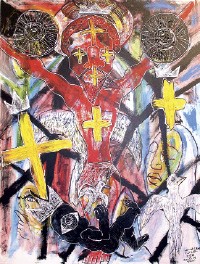From Elizabeth Alley’s saturate, crisp-edged depictions of the 1950s in Perry Nicole’s 10th Anniversary Exhibition to Mary Stubbs’ black-and-white infrared photography at the Buckman to Daisy Craddock’s brooding Southern landscapes at David Lusk, Memphis galleries are bringing in the new year with shows that run the gamut of sensibility and style.
Rod Moorhead, one of Perry Nicole’s newest artists, counterpoints Elizabeth Alley’s paintings of starched white blouses and Danish modern divans with Furies #6, a pit-fired clay sculpture of a young woman who appears to take shape or to decompose in front of our eyes. Pieces of cloth (or perhaps Eden’s proverbial serpents) wrap around the loins and barely pubescent breasts of a creature who looks like a hybrid of a fallen angel and teenage Eve. We can see the sculptor’s thumbprints in the figure’s ruffled, sooty brown wings and the armless, half-formed body that still looks malleable. The half-closed eyes and relaxed mouth (in limbo? a little dazed?) complete Moorhead’s haunting evocation of what it feels like to be human, to be able to glimpse the divine while still trapped in a mortal coil.
Perry Nicole’s anniversary exhibition also provides viewers with an opportunity to see, side by side, works by a wide range of accomplished landscape artists, including Martha Kelly’s signature vision of summer, Top of the Island, in which a canopy of trees casts cool, dark shadows across a grassy field that looks lime-green in full sunlight.
Instead of the expressive female forms for which she is best known, Mary Reed contributes textured, sinuous landscapes to the show. In Boundaries, for example, the bare branches of a misshapen tree reach out toward a winding river and layers of handmade paper, fabric, and paint suggest the heft and roughhewn surface of large boulders as well as the rise and fall of waters rushing toward us.
Arline Jernigan fearlessly works and reworks the surface of her mixed-media, nearly monochromatic painting Flight. We soar through overcast skies past crumbling limestone rock faces, where plant life just begins to take hold in the crevices, where ideas just begin to take shape on an almost blank tabula rasa that is one of the subtlest and most assured works in the show.
Through February 26th
TU, a touring company noted for its inventive syntheses of dance forms (including ballet, contemporary, and African), performs Friday, January 29th, at the Buckman Performing & Fine Arts Center. TU’s choreography has been described as “beautiful, intelligent and singularly wrought.” The same can be said of the watercolors, ceramics, and black-and-white photography mounted just outside the Buckman auditorium in the Levy Gallery’s January exhibition, “Seen, Shaped, Considered: Works Inspired by the Natural World.”
In one of the most mature works of her career, Mary Stubbs — a photographer noted for images of crosses and church steeples — evokes transcendence with infrared light and a trinity of trees. The trees at bottom left and bottom right of Beyond the Moment are barren. Across the top of the work, branches of a third tree are covered with buds backdropped by luminous jet contrails and a preternaturally dark sky.
Anne Froning Wike creates a sense of wonder with ceramics. A prime example is Lotus Gazing Bowl — Amethyst, a clay vessel shaped out of ever-widening circles of translucent mauve petals flecked with dark green. At the center of this inventive, exquisitely beautiful mandala is a tiny pale-pink rose.
Clouds roll across the top edge of Tom Pellet’s satisfyingly complex, delicately observed watercolor All That Glitters. Near the bottom, a geometric abstraction of greens and corals repeats the colors in the leaves and petals of a large camellia that fills the rest of the work.
Through February 12th
Massive oaks, magnolias, and crepe myrtles weighed down with dusty mauve blossoms nearly fill the canvases in “Points South,” Daisy Craddock’s show at David Lusk. There are no breezes, no rippled waters, no rustling of olive-green foliage in Craddock’s oil-on-linen Magnolia, Midday. Instead, the placid gray surface of a lake reflects an overcast sky. In hands less skilled than Craddock’s, colors muted and images blurred by thick atmosphere could feel suffocating.
For viewers who both rue and revere the Deep South’s all-encompassing humidity (including Craddock, who grew up in Memphis in the ’50s when open porches and ceiling fans were the norm, not central air-conditioning), Craddock’s honest and elegiac paintings register as brooding rather than oppressive, contemplative instead of languishing.

